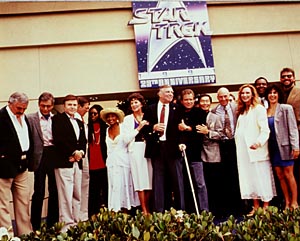|
Star Trek Animated - The animated series
Star Trek Animated - The series was aired under the name Star Trek, but it has become widely known as Star Trek: The Animated Series (or abbreviated as ST:TAS or TAS). It was produced by Filmation and ran for two seasons with a total of twenty-two half-hour episodes. It featured most of the original cast performing the voices for their characters. While the freedom of animation afforded large alien landscapes and exotic lifeforms, budget constraints were a major concern and animation quality was poor. A few episodes are especially notable due to contributions from well-known science fiction authors. The series is not considered to be canon, with the episode, "Yesteryear" being largely an exception, which has caused controversy among some fans.
Produced by FilmationThe series was produced by Filmation and ran for two seasons, 1973 and 1974, airing a total of twenty-two half-hour episodes. It featured most of the original cast performing the voices for their characters, except for Pavel Chekov (Walter Koenig). He was replaced by Lieutenant Arex, a member of a species which had three arms and three legs. Another semi-regular addition to the cast was Lt. M'Ress, a female cat-like alien. (An earlier Filmation proposal had children assigned to each of the senior officers as cadets, including a young Vulcan for Mr. Spock.) Koenig was not forgotten and later wrote an episode of the series, becoming the first Star Trek actor to write a Star Trek story in the process.
Takes place after the ST:TOSIt is generally assumed that the episodes in the series take place after the events of the Original Series, possibly during the last year of the NCC-1701's five-year mission. However this is never stated on screen. It is impossible to support this notion using the stardates mentioned in the episodes, since they are often inconsistent with the Original Series. One episode, "Magicks of Megas-Tu" carries a stardate that would place it before the first episode of the series, while another episode carries a stardate well after the date given in Star Trek: The Motion Picture.
The Stardate - What is it?Another consideration could be given to The Making of Star Trek, a novel-length document on the show. It explains some of the technology of the Star Trek universe, including Star Date: the term refers to measuring the continuum of time-space, something necessitated by having ships that can move faster than light. Essentially, Star Date can vary by spatial position and is not, generally, a linear measure of the passage of time. This canonical definition is often overlooked because it is quite beyond present-day technology and devoting hours of study to it would violate the basic premise of Star Trek: it's supposed to be fun. Interested readers might start by looking at Minkowsky geometry, but even Roddenberry admitted that he did not know exactly what it meant.
Filming and recording took place at different timesAs is usual for animation, the voice actors did not perform together but recorded their parts separately to avoid clashing with other commitments. For instance, William Shatner, who was touring in a play at the time, would record his lines in whatever city he happened to be in and have the tapes shipped to the studio. Trek regulars James Doohan and Majel Barrett performed virtually all of the "guest star" characters in the series, except for a few notable exceptions (Sarek, Cyrano Jones and Harcourt Fenton Mudd, who were performed by their original actors from The Original Series). Occasional other guest voices were also used, such as Ed Bishop (Commander Straker on UFO) who voiced a character in "Magicks of Megas-Tu".
Filming quality varies considerablyWhile the freedom of animation afforded large alien landscapes, budget constraints were a major concern and animation quality was generally poor, with very liberal use of stock shots. There were also occasional mistakes, such as characters appearing on screen who were elsewhere, or a character supposed to appear on the bridge main screen appears in front, indicating bad ordering of animation plates. These were typically one-off errors however. Occasionally, though, parts of episodes would be animated at a near-theatrical quality level.
Several notable science fiction authors contributed to the seriesSeveral episodes were novelized by Alan Dean Foster and put into collections of three stories each called "Captain's Logs." A few episodes are especially notable due to contributions from well-known science fiction authors:
Gene Roddenberry didn't consider it canon...For a variety of reasons (most likely legal ones, such as the use of concepts from Niven's own works), Paramount Pictures does not consider The Animated Series to be true Star Trek canon with "Yesteryear" being partially an exception. Also, Gene Roddenberry reportedly asked soon before his death that the series not be considered canon.
|




